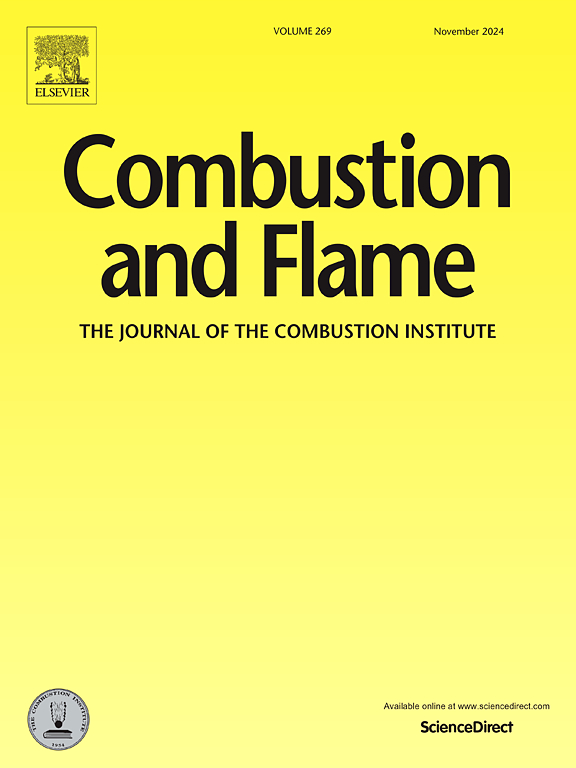Analysis of combustion behavior and regression rate of hypergolic solid fuels in counterflow spray experiment
IF 5.8
2区 工程技术
Q2 ENERGY & FUELS
引用次数: 0
Abstract
Recent studies have shown the advantages of hypergolic solid fuels in hybrid rockets, particularly their short ignition delays and simplified designs. However, research on their combustion behavior and regression rates remains limited. This study attempts to address some of these gaps using low-density polyethylene-based fuels embedded with sodium borohydride and 90 wt% hydrogen peroxide as the oxidizer. A modified counterflow spray experiment was employed, revealing unique combustion features and surface structures, such as char spots and bulges. A novel technique was developed to measure the fuel regression rate under an oxidizer spray, yielding averages between 0.39 to 0.52 mm/s at oxidizer mass flow rates of 0.38 to 0.43 g/s, significantly higher than those obtained with oxygen counterflow burners. Regression rates increased with higher flow rates and additive concentrations, primarily due to enhanced surface reactions. The measured combustion delay times were considerably longer than the ignition delay times observed in droplet tests, highlighting the importance of evaluating ignition performance under spray conditions. Reignition tests revealed longer ignition and combustion delay times compared to the first ignition, with averages increasing from 23 to 162 ms and 158 to 342 ms, respectively. Thermochemical analysis and Fourier transform infrared spectroscopy (FTIR) identified the char layer as primarily sodium metaborate tetrahydrate, which is identified as a cause for its reduced reactivity with the oxidizer during reignition.
自燃固体燃料逆流喷雾燃烧特性及回归率分析
最近的研究显示了混合火箭中使用双酚固体燃料的优势,特别是其较短的点火延迟和简化的设计。然而,对其燃烧行为和回归率的研究仍然有限。本研究尝试使用嵌入硼氢化钠和 90 wt%过氧化氢作为氧化剂的低密度聚乙烯基燃料来弥补其中的一些不足。研究采用了改良的逆流喷雾实验,揭示了独特的燃烧特征和表面结构,如焦斑和凸起。在氧化剂质量流量为 0.38 至 0.43 克/秒时,平均值为 0.39 至 0.52 毫米/秒,明显高于氧气逆流燃烧器的平均值。回归率随着流速和添加剂浓度的提高而增加,这主要是由于表面反应增强所致。测得的燃烧延迟时间大大长于液滴试验中观察到的点火延迟时间,这凸显了在喷雾条件下评估点火性能的重要性。复燃测试显示,与首次点火相比,点火和燃烧延迟时间更长,平均值分别从 23 毫秒增至 162 毫秒,从 158 毫秒增至 342 毫秒。热化学分析和傅立叶变换红外光谱(FTIR)确定炭层主要是偏硼酸钠四水合物,这也是其在复燃过程中与氧化剂反应性降低的原因。
本文章由计算机程序翻译,如有差异,请以英文原文为准。
求助全文
约1分钟内获得全文
求助全文
来源期刊

Combustion and Flame
工程技术-工程:化工
CiteScore
9.50
自引率
20.50%
发文量
631
审稿时长
3.8 months
期刊介绍:
The mission of the journal is to publish high quality work from experimental, theoretical, and computational investigations on the fundamentals of combustion phenomena and closely allied matters. While submissions in all pertinent areas are welcomed, past and recent focus of the journal has been on:
Development and validation of reaction kinetics, reduction of reaction mechanisms and modeling of combustion systems, including:
Conventional, alternative and surrogate fuels;
Pollutants;
Particulate and aerosol formation and abatement;
Heterogeneous processes.
Experimental, theoretical, and computational studies of laminar and turbulent combustion phenomena, including:
Premixed and non-premixed flames;
Ignition and extinction phenomena;
Flame propagation;
Flame structure;
Instabilities and swirl;
Flame spread;
Multi-phase reactants.
Advances in diagnostic and computational methods in combustion, including:
Measurement and simulation of scalar and vector properties;
Novel techniques;
State-of-the art applications.
Fundamental investigations of combustion technologies and systems, including:
Internal combustion engines;
Gas turbines;
Small- and large-scale stationary combustion and power generation;
Catalytic combustion;
Combustion synthesis;
Combustion under extreme conditions;
New concepts.
 求助内容:
求助内容: 应助结果提醒方式:
应助结果提醒方式:


